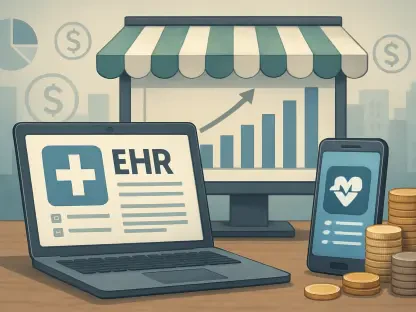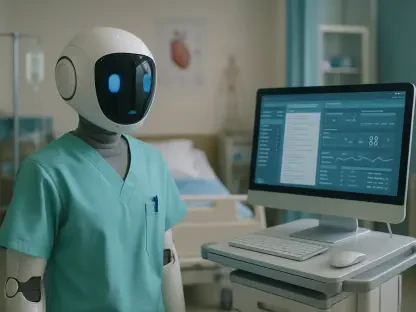In the rapidly shifting landscape of healthcare, electronic health record (EHR) systems stand as critical tools for managing vast amounts of patient data, yet they often fail to deliver the efficiency and usability that clinicians desperately need, leading to frustration. Far too often, healthcare providers find themselves bogged down by clunky interfaces and repetitive administrative tasks, diverting their attention from what matters most—patient care. Generative artificial intelligence (AI) emerges as a transformative force, offering a pathway to reimagine EHR workflows with pinpoint accuracy and remarkable adaptability. This technology promises not just to patch up existing flaws but to fundamentally reshape how healthcare data is handled, ensuring better outcomes for both providers and patients. Drawing from cutting-edge research, this exploration uncovers how AI-driven innovation can address longstanding challenges and pave the way for a more streamlined, patient-focused future in medical technology.
The Promise of AI in Healthcare Technology
Redefining Efficiency and Accuracy
The inefficiencies plaguing current EHR systems often stem from their inability to manage the overwhelming volume of data generated in modern healthcare settings, leading to delays and mistakes that impact patient safety. Generative AI steps in as a powerful solution by automating mundane tasks such as data entry, which not only minimizes human error but also frees up valuable time for clinicians to focus on direct care. By taking over these repetitive duties, AI ensures that records are updated with precision, reducing the likelihood of discrepancies that could compromise treatment plans. This automation is more than a convenience—it’s a critical step toward enhancing the reliability of healthcare delivery. Beyond just saving time, the technology can prioritize urgent information, ensuring that critical data isn’t buried under less pressing updates, thereby supporting faster, more informed decision-making in high-stakes environments.
Another key advantage of AI lies in its ability to streamline access to complex datasets, presenting information in a way that’s both intuitive and actionable for healthcare professionals. Rather than forcing clinicians to sift through endless screens or disjointed records, AI synthesizes disparate data points into cohesive summaries, enabling quick identification of trends or anomalies. This capability is particularly vital during emergencies when every second counts, as it allows for rapid assessment without sacrificing accuracy. Moreover, AI can flag potential issues—such as conflicting medications or overlooked test results—before they escalate, acting as a safeguard within the system. The result is a workflow that not only boosts efficiency but also builds confidence among providers that the information at their fingertips is both comprehensive and correct, ultimately elevating the standard of care across the board.
Adapting Workflows with Programming Principles
One of the most innovative aspects of integrating AI into EHR systems is the application of programming principles to create workflows that are inherently dynamic and responsive to real-world needs. Inspired by software engineering, this approach treats EHR platforms as adaptable frameworks that can adjust based on user interactions and evolving medical protocols. Unlike static systems that require cumbersome overhauls to accommodate change, these AI-driven designs learn from usage patterns, refining their functionality over time. This adaptability ensures that healthcare providers aren’t stuck with outdated tools, but instead work with systems that mirror the fluidity of clinical practice, enhancing both productivity and satisfaction in daily operations.
Equally important is the focus on scalability, ensuring that EHR systems built with AI can keep pace with technological advancements and growing demands over the coming years. By embedding programming-inspired logic, these platforms are designed to integrate seamlessly with emerging tools, from advanced diagnostics to wearable health tech, without requiring complete redesigns. This forward-thinking structure not only protects investments in healthcare technology but also prepares organizations for future challenges, such as increasing patient volumes or regulatory shifts. The emphasis on long-term relevance means that hospitals and clinics can adopt AI solutions with confidence, knowing that their systems will remain robust and effective as the landscape of medicine continues to transform at a rapid pace.
Enhancing User and Patient Experience
Supporting Clinicians at the Core
A primary goal of AI integration in EHR systems is to alleviate the heavy administrative burden that often weighs on clinicians, pulling them away from meaningful patient interactions. By automating routine documentation and organizing patient data into easily digestible formats, AI tools significantly reduce the cognitive load on healthcare providers. This shift allows doctors and nurses to spend more time at the bedside, addressing patient concerns and building trust, rather than wrestling with tedious paperwork or navigating convoluted digital menus. The impact of this change extends beyond mere convenience—it directly correlates with lower rates of burnout and higher job satisfaction among medical staff, fostering a healthier workforce capable of delivering top-tier care consistently.
Equally critical to this transformation is the role of comprehensive training programs in ensuring that clinicians can fully leverage AI-enhanced EHR systems. Without proper education on how to interact with these advanced tools, even the most sophisticated technology risks being underutilized or misunderstood, negating its potential benefits. Tailored training initiatives must focus on practical application, guiding healthcare professionals through real-world scenarios to build confidence in AI functionalities like decision support or error detection. Additionally, ongoing support and feedback mechanisms are essential to address challenges as they arise during adoption. By prioritizing user engagement and skill development, healthcare organizations can bridge the gap between cutting-edge innovation and everyday practice, ensuring a smooth transition that maximizes the technology’s impact on workflow efficiency.
Personalizing Patient Care
Generative AI’s ability to analyze vast datasets opens up new possibilities for delivering personalized care through EHR systems, fundamentally changing how treatment plans are developed. By identifying unique patterns in a patient’s medical history, lifestyle, and even genetic information, AI can assist clinicians in crafting interventions tailored to individual needs rather than relying on broad, generalized approaches. This precision not only improves the effectiveness of treatments but also enhances patient satisfaction, as individuals feel seen and understood by their healthcare providers. The move toward customization represents a significant leap forward, addressing long-standing gaps in care delivery and ensuring that each patient receives attention that aligns with their specific circumstances.
This shift also signals a broader transition to holistic care models, where the focus extends beyond treating symptoms to understanding the whole person. AI-driven EHR systems support this by integrating diverse data points—such as social determinants of health or behavioral trends—into a comprehensive view accessible to clinicians at the point of care. Such integration enables providers to address underlying factors that might influence recovery, like stress or environmental conditions, fostering more empathetic and effective care strategies. Furthermore, patients benefit from greater transparency, as AI can help explain complex medical information in simpler terms through summaries or visual aids. This patient-centered approach, powered by intelligent technology, redefines healthcare as a collaborative journey, prioritizing individual well-being over one-size-fits-all solutions.
Navigating Challenges and Future Horizons
Addressing Ethical Concerns
As AI becomes more deeply embedded in EHR workflows, safeguarding patient privacy and maintaining trust emerge as paramount concerns that must be addressed with diligence and transparency. The vast amounts of sensitive data processed by these systems raise significant risks if not handled with strict security protocols, potentially eroding confidence in healthcare technology. Clear policies must be established to ensure compliance with regulations and to protect patient consent, providing explicit guidelines on how information is used and shared. By prioritizing data security through encryption and access controls, healthcare organizations can mitigate threats while harnessing AI’s capabilities, striking a balance that reassures patients their personal details remain confidential and safe from misuse.
Equally important is the need to balance innovation with ethical responsibility, ensuring that the rush to adopt AI does not overshadow the fundamental principles of healthcare. Transparency in how algorithms make decisions—such as flagging health risks or suggesting treatments—is vital to prevent biases or errors that could harm patients. Regulatory frameworks should be developed in tandem with technological advancements to address accountability, ensuring that AI serves as a supportive tool rather than an unchecked authority in clinical settings. Engaging stakeholders, including patients and providers, in discussions about AI’s role fosters a shared understanding and builds a foundation of trust. This careful approach ensures that the benefits of enhanced workflows are realized without compromising the integrity of patient care or ethical standards.
Envisioning Tomorrow’s Innovations
Looking to the future, the potential of generative AI in EHR systems extends far beyond current applications, promising tools like predictive analytics that can anticipate patient needs before issues arise. By analyzing historical data and real-time inputs, AI could forecast risks such as disease outbreaks or individual health declines, enabling proactive interventions that save lives and reduce costs. Additionally, advancements in intelligent data management could further optimize how information is stored and retrieved, eliminating inefficiencies that plague even modern systems. These innovations hold the power to elevate healthcare delivery on a global scale, ensuring that resources are allocated effectively and that patients receive timely, precise care tailored to emerging trends and personal health trajectories.
Achieving this ambitious vision requires robust cross-disciplinary collaboration, uniting experts from healthcare, computer science, and user experience design to create solutions that are both cutting-edge and practical. Such teamwork ensures that AI tools are not only technologically sound but also intuitive for end-users, addressing real-world challenges faced by clinicians and patients alike. Partnerships across sectors can drive the development of standardized protocols, making AI integration seamless across diverse healthcare environments. By fostering an ecosystem of shared knowledge and innovation, the industry can tackle complex problems—from scalability to accessibility—while laying the groundwork for future breakthroughs. This collaborative spirit turns obstacles into opportunities, setting a precedent for how technology and human expertise converge to redefine standards of care in remarkable ways.









